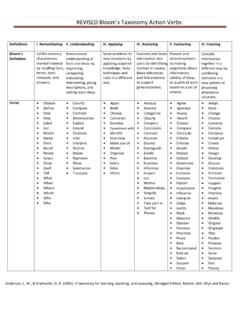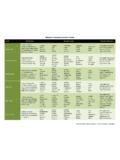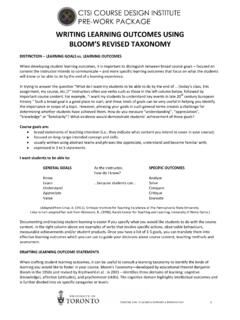Transcription of A Model of Learning Objectives - Iowa State University
1 A Model of Learning Objectives based onA taxonomy for Learning , Teaching, and Assessing:A Revision of bloom 's taxonomy of Educational Objectives *Metacognitive knowledge is a special case. In this Model , metacognitive knowledge is knowledge of [one s own]cognition and about oneself in relation to various subject matters .. (Anderson and Krathwohl, 2001, p. 44).(Table 1 adapted from Anderson and Krathwohl, 2001, p. 46.) Table 1. The Knowledge Dimension major types and subtypes factualconceptualproceduralmetacognitive *concrete knowledgeabstract knowledgeknowledge of terminologyknowledge of specific details and elementsknowledge of subject-specific skills and algorithmsknowledge of subject-specific techniques and methodsknowledge of criteria for determining when to use appropriate proceduresstrategic knowledgeknowledge about cognitive tasks.
2 Including appropriate contextual and conditional knowledgeself-knowledgeknowledge of classifications and categoriesknowledge of principles and generalizationsknowledge of theories, models, and structuresAmong other modi ications, Anderson and Krathwohl s (2001) revision of the original bloom s taxonomy ( bloom & Krathwohl, 1956) rede ines the cognitive domain as the intersection of the Cognitive Process Dimension and the Knowledge Dimension. This document offers a three-dimensional representation of the revised taxonomy of the cognitive domain. Although the Cognitive Process and Knowledge dimensions are represented as hierarchical steps, the distinctions between categories are not always clear-cut.
3 For example, all procedural knowledge is not necessarily more abstract than all conceptual knowledge; and an objective that involves analyzing or evaluating may require thinking skills that are no less complex than one that involves creating. It is generally understood, nonetheless, that lower order thinking skills are subsumed by, and provide the foundation for higher order thinking Knowledge Dimension classi ies four types of knowledge that learners may be expected to acquire or construct ranging from concrete to abstract (Table 1).The Cognitive Process Dimension represents a continuum of increasing cognitive complexity from lower orderthinking skills to higher order thinking skills.
4 Anderson and Krathwohl (2001) identify nineteen speci ic cognitive processes that further clarify the scope of the six categories (Table 2).(Table 2 adapted from Anderson and Krathwohl, 2001, pp. 67 68.)Table 2. The Cognitive Processes dimension categories & cognitive processes and alternative names rememberunderstandapplyanalyzeevaluatecr eatelower order thinking skillshigher order thinking skillsThis taxonomy provides a framework for determining and clarifying Learning Objectives . Learning activities often involve both lower order and higher order thinking skills as well as a mix of concrete and abstract clarifying paraphrasing representing translatingexemplifying illustrating instantiatingclassifying categorizing subsumingsummarizing abstracting generalizinginferring concluding extrapolating interpolating predictingcomparing contrasting mapping matchingexplaining constructing modelsexecuting carrying outimplementing usingdifferentiating discriminating distinguishing focusing selectingorganizing
5 Finding coherence integrating outlining parsing structuringattributing deconstructingchecking coordinating detecting monitoring testingcritiquing judginggenerating hypothesizingplanning designingproducing constructingrecognizing identifyingrecalling retrievingA Model of Learning Objectives based onA taxonomy for Learning , Teaching, and Assessing: A Revision of bloom s taxonomy of Educational Objectivesby Rex Heer, Center for Excellence in Learning and Teaching, Iowa State University is licensed under a Creative Commons Attribution-ShareAlike International : these are Learning Objectives not may be useful to think of preceding each objective with something like: Students will be able to.
6 *Anderson, (Ed.), Krathwohl, (Ed.), Airasian, , Cruikshank, , Mayer, , Pintrich, , Raths, J., & Wittrock, (2001). A taxonomy for Learning , teaching, and assessing: A revision of bloom 's taxonomy of Educational Objectives (Completeedition).New statement of a Learning objective contains a verb (an action ) and an object (usually a noun). The verb generally refers to [actions associated with] the intended cognitiveprocess. The object generally describes the knowledge students are expected toacquireor construct. (Anderson and Krathwohl, 2001, 5)
7 In this Model , each of the colored blocks shows an example of a Learning objective that generally corresponds with each of the various combinations of the cognitive process and and secondary features of a new frequentlyasked most complete list of consistencyamong a log of daily adhesivesby high and low relevanceof efficientproject to perform assembly tests of water compliancewith of sampling forretaining s responseto culture thatmatch one ons tructone one s innovative Learning


